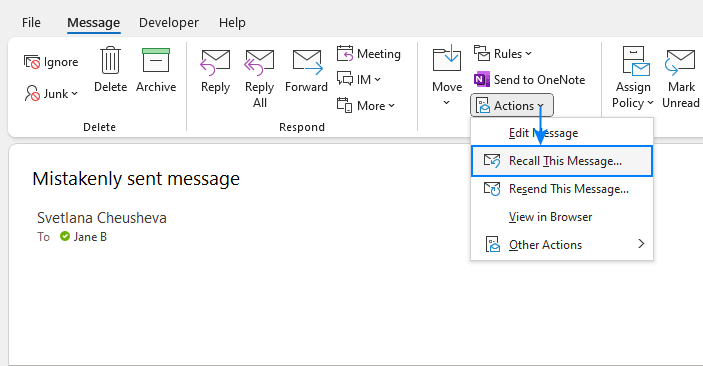How to Recall an recall outlook email: A Step-by-Step Guide

Introduction to Email Recall
recall outlook email communication has become an essential component of professional interactions, facilitating rapid information exchange and collaboration across various sectors. However, the advent of emails also comes with its challenges, particularly the potential for errors in message delivery. The capability to recall Outlook emails serves as a crucial tool for mitigating these mistakes and enhancing communication efficacy.
Recalling an email allows senders to retract messages that may have reached unintended recipients or contained inaccuracies. This feature is particularly advantageous in scenarios where sensitive information has been mistakenly shared or when important data has not been presented correctly. For example, if a sensitive report is accidentally sent to the wrong colleague, utilizing the email recall feature can help rectify the situation before further complications arise. Additionally, in instances where an email contains factual errors, recalling the message allows the sender to promptly provide corrected information, maintaining professionalism and clarity in communication.
Understanding the functionality of recall outlook email recall feature is pertinent for professionals who rely heavily on electronic correspondence. Awareness of this tool can prevent misinformation from circulating within teams and ensure that critical communications are accurately directed. Moreover, it emphasizes the importance of double-checking email content and recipients before pressing the send button. By delving into the specifics of how to recall an Outlook email effectively, professionals will not only enhance their personal communication strategies but will also contribute to a culture of precision and responsibility in their workplaces.
Understanding the Recall Feature in Outlook
The recall feature in recall outlook email is designed to allow users to retract an email that has been mistakenly sent to a recipient. This feature, though seemingly convenient, comes with specific limitations and conditions that users must be aware of to utilize it effectively. When a message is recalled, the recipient receives a notification indicating that the original email has been retracted. If successful, the original message will be removed from the recipient’s inbox, provided certain criteria are met.
For the recall to work, both the sender and the recipient must be using Microsoft Exchange or Microsoft 365. Additionally, the email must not have been opened by the recipient. If the recipient has already read the message, the recall attempt will fail, and they will still have access to the original email. Moreover, recalls do not function effectively when emails are sent outside of the organization, as the feature relies on the specific configurations of Exchange servers to process such requests.
It’s important to note that the recall feature is not the only way to address email mistakes. In many instances, sending a follow-up email can be a more straightforward solution. This simple act of communication allows the sender to clarify any misunderstandings or correct errors without relying on potentially ineffective recall attempts. Unlike recalling an email, follow-up messages are guaranteed to reach the recipient while providing an opportunity for clear communication.
When considering whether to use the recall feature, users should remain cautious. Not every recall attempt will succeed, and relying solely on this function can lead to further confusion or embarrassment. Understanding the nuances of how to recall Outlook email is essential for effective communication and minimizing the risk of misunderstandings.
Step-by-Step Instructions to Recall an Email in Outlook
Recalling an email in recall outlook email can be a straightforward process, provided the proper steps are followed. Depending on the version of Outlook you are using—whether it be the desktop application or Outlook on the web—the methods slightly differ. Below are step-by-step instructions tailored for both variants.
For users of the recall outlook email desktop application, the following steps apply:
1. Open Outlook and navigate to the “Sent Items” folder, where you can find the email you wish to recall.
2. Double-click on the email to open it in a new window.
3. In the ribbon at the top, click on “File” and then choose “Info.”
4. Select “Message Resend and Recall” and then click “Recall This Message.”
5. You will be prompted with two options: “Delete Unread Copies of This Message” or “Delete Unread Copies and Replace with a New Message.” Choose your preferred option and click “OK.”
It is essential to note that successful recall is contingent upon various factors, such as the recipient’s email settings and whether they have already read the message. Be aware that if recipients use email services other than Outlook, the recall function may not work.
For those using Outlook on the web, the recall feature is not available as it is in the desktop version. Instead, you may want to opt for sending a follow-up email. To achieve this:
1. Open your “Sent Items” and locate the problematic email.
2. Click on “Forward” or “Reply All” to address the recipients.
3. Clearly state that the previous email was sent in error and include the corrected information if applicable.
In conclusion, understanding how to recall an recall outlook email varies based on the platform being utilized. Following these instructions provides a pathway to managing sent emails effectively, minimizing miscommunication. With the appropriate approach, users can ensure that their email communications remain accurate and professional.
Common Challenges When Recalling an Email
Recalling an recall outlook email can often present users with various challenges that may hinder the success of the recall process. Understanding these common difficulties can significantly improve the likelihood of a successful email recall. One prevalent issue is timing. The effectiveness of recalling an email largely depends on how quickly a user acts after sending the erroneous message. If the recipient has already opened the email, the recall attempt will fail. In such situations, the best approach is to act swiftly—users should monitor their sent items and recall as soon as they identify an issue. Additionally, sending a follow-up message to clarify the error may help, especially if time is of the essence.
Another challenge arises from email configurations. For example, if the recipient is using a different email client or service, such as Gmail, attempting to recall an recall outlook email may not work at all. Users should be aware that the recall function is designed specifically for recall outlook email and Microsoft Exchange recipients. To mitigate this risk, it is advisable to double-check the recipient’s email settings or consider contacting them directly if the matter is urgent.
Moreover, the context of the recalled email can play a significant role. If the email contained sensitive information, the recipient may perceive the recall attempt as an admission of an error, leading to potential misunderstandings. In such cases, it’s essential to draft a polite and clear follow-up communication that addresses the circumstances surrounding the recall while maintaining professionalism.
Overall, while recalling an email in Outlook is a useful feature, it is not foolproof. Users must navigate challenges such as timing, recipient email configurations, and the implications of the content within the emailed message. By being cognizant of these potential obstacles, users can take proactive measures to improve the effectiveness of their email recall efforts.
Alternative Approaches to Mitigate Email Mistakes
While the ability to recall Outlook email is a valuable feature, there are alternative strategies that can help address email mistakes effectively. One of the most straightforward approaches is to send an apology email. If you notice an error shortly after clicking ‘send,’ composing a brief and polite email acknowledging the mistake can help rectify the situation. This message should clearly state what the error was, express your regret, and offer the correct information. Such transparency fosters accountability and maintains professionalism in communication.
Another method of addressing email inaccuracies is through a follow-up email. Instead of attempting to recall Outlook email, you can choose to send correspondence that corrects the previous information. In this follow-up, it is important to ensure that your message is clear and concise, explicitly stating what the prior error was and providing the correct data. This method not only clarifies any misunderstandings but also reinforces good communication practices among recipients.
Preventive measures also play a vital role in minimizing recall outlook email mistakes. Using email etiquette wisely can drastically reduce the likelihood of errors. Before sending any email, it is beneficial to proofread for grammatical mistakes, verify the recipient’s address, and review the content for clarity. Additionally, utilizing the ‘Delay Delivery’ option in Outlook can provide a safety net, allowing a brief period during which you can reconsider your message before it is sent out to recipients. By implementing these practices, individuals can enhance their email communication skills, making it less likely that they will have to rely on options like recalling Outlook email. Taking these proactive steps ensures a high level of professionalism in correspondences, fostering clearer communication in all contexts.
When Not to Use the Email Recall Feature
The email recall feature in Outlook can prove to be invaluable for rectifying mistakes, but there are situations where its use may not be advisable or effective. Understanding when not to utilize this feature is essential for improving communication practices and managing expectations. One primary scenario where email recall may not be appropriate is when the recipient is using an email service that does not support the recall function. For example, if the email is sent to someone using Gmail or another platform, the recall request will not work, leaving the sender with no solution to their original error.
Another critical situation to avoid using the recall feature is when the recall outlook email has already been read by the recipient. Once the message has been opened, it is unlikely that the recall attempt will be successful. In fact, the recipient will typically receive a notification regarding the recall, which can create confusion or raise suspicion about the sender’s intentions. Hence, if an email contains sensitive or damaging information, sending a recall request may instead draw more attention to the original message, further complicating the matter.
Moreover, using the recall option after a significant delay can also lead to ineffective results. Email clients frequently refresh, and if enough time has passed since the original recall outlook email was sent, it is possible that the message has already been deleted or archived by the recipient, thus making the recall redundant. Additionally, relying on this feature in critical business communications can undermine professionalism. Rather than attempting to navigate an imperfect solution, it may be more beneficial to send a follow-up email or direct communication to clarify the intention behind the original message. Thus, understanding these limitations can improve decision-making regarding the recall Outlook email function.
Best Practices for Using Outlook Email Recall
To successfully recall an recall outlook email, it is essential to consider several best practices that can enhance the likelihood of a successful recall. One primary aspect is the timing of the recall. It is advisable to initiate the recall as soon as you realize the email has been sent erroneously or contains incorrect information. The sooner the action is taken, the more effective the recall is likely to be.
Another important factor to consider is whether the email remains unread by the recipient. The recall feature only works if the recipient has not yet opened the recall outlook email. Hence, it is critical to monitor the recipient’s activity closely—if they are known to be active on their email or if there is a high likelihood of a prompt read, the chances of success diminish. To optimize outcomes, it is advisable to avoid sending sensitive or critical information unless you are certain about the contents of the message.
Additionally, consider the recall outlook email settings both for yourself and the recipient. Outdated or incompatible versions of Outlook may affect the functionality of the recall feature. Ensure that both you and the recipient are utilizing compatible versions of Outlook. Furthermore, if the recipient’s email is hosted on a different platform or uses non-Outlook accounts, the recall function may not work as intended.
User etiquette is another crucial element to address in the recall outlook email recall process. When sending an erroneous email, proactively apologizing or acknowledging the mistake in a follow-up email can foster better communication and understanding between both parties. Transparency and professionalism should guide all email interactions, especially when you may need to recall Outlook emails.
By adhering to these best practices, users can enhance their chances of successfully recalling an email in Outlook while maintaining professionalism in their communication.
Case Studies: Successful and Unsuccessful Email Recalls
The email recall function in recall outlook email is a powerful tool, yet it is not foolproof. To better understand its effectiveness, we can analyze several case studies that illustrate both successful and unsuccessful email recall attempts.
One notable success story involves a scenario where a manager accidentally sent an recall outlook email featuring confidential client information to a wrong recipient within the same organization. By promptly initiating the recall of the Outlook email, the manager was able to successfully retract the message before it was read. The recipient received a notification stating the email had been recalled, demonstrating the effectiveness of Outlook’s functionality when both sender and receiver are within the same network. The key takeaway from this case is the importance of acting swiftly; the quicker the recall request is made, the higher the chances of success.
In contrast, there are instances where recalls have failed dramatically. Consider a situation where an employee mistakenly sent an email containing sensitive financial data to an external recipient, thinking they were sending it internally. Despite the prompt initiation of a recall, the external recipient had already accessed the email. In this case, the recall was ineffective because Outlook’s recall ability does not function across different email servers. This highlights a critical limitation of the feature and underscores the necessity for users to double-check recipient details before sending emails. Additionally, it serves as a reminder for companies to educate their staff about the potential pitfalls when utilizing features such as recall in recall outlook email
These case studies exemplify the varying degrees of success associated with recalling an recall outlook email Familiarizing oneself with the recall process, understanding its limitations, and acting promptly can significantly influence the final outcome of the attempt.
Conclusion: The Future of Email Recall
In this guide, we have explored the nuances of recalling an recall outlook email, detailing the steps involved and highlighting the implications of the feature in a professional context. The capability to recall an email is instrumental for maintaining professionalism, resolving misunderstandings, and ensuring that accurate information is conveyed. However, it is not without limitations. Factors such as the recipient’s email settings, timing, and network conditions can significantly affect the success of an email recall attempt.
Looking ahead, the functionality of recall outlook email recall is likely to evolve alongside technological advancements. As email providers continuously enhance their platforms, we may expect more sophisticated features to ensure the accuracy and relevancy of emails. Integration with artificial intelligence could lead to smarter drafting tools that predict potential errors before the email is sent, reducing reliance on recall functionalities. Additionally, as more organizations adopt remote and flexible work arrangements, the communication practices may shift, necessitating further improvements in email recall technology.
Furthermore, as the digital workspace grows, it becomes ever more critical for professionals to reflect on their email practices. Developing a meticulous approach to composing recall outlook email can help mitigate the need for recall actions. Incorporating best practices such as proofing emails thoroughly and being cognizant of tone and content can foster clearer communication. Accordingly, users of recall outlook email should embrace the tools available for effective communication, including the recall feature, while also considering how they can enhance their overall email etiquette. Adopting a proactive mindset will not only aid in effective communication but will also promote a more efficient use of email resources in the workplace.
You may read also this ukmaganews




